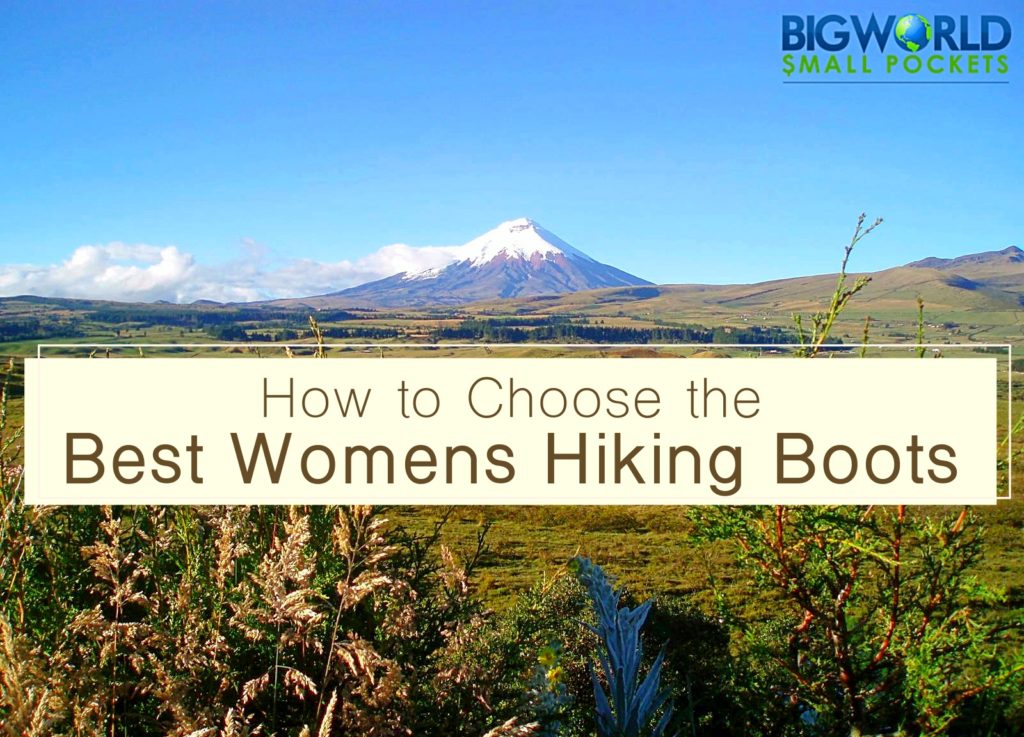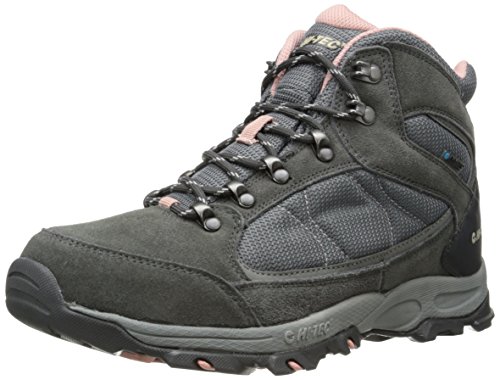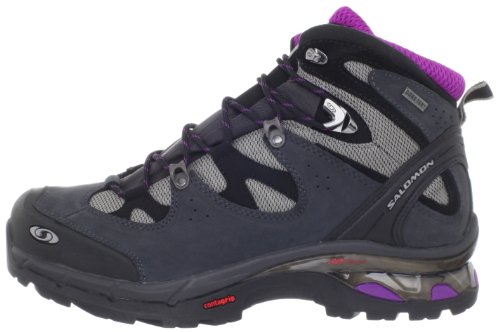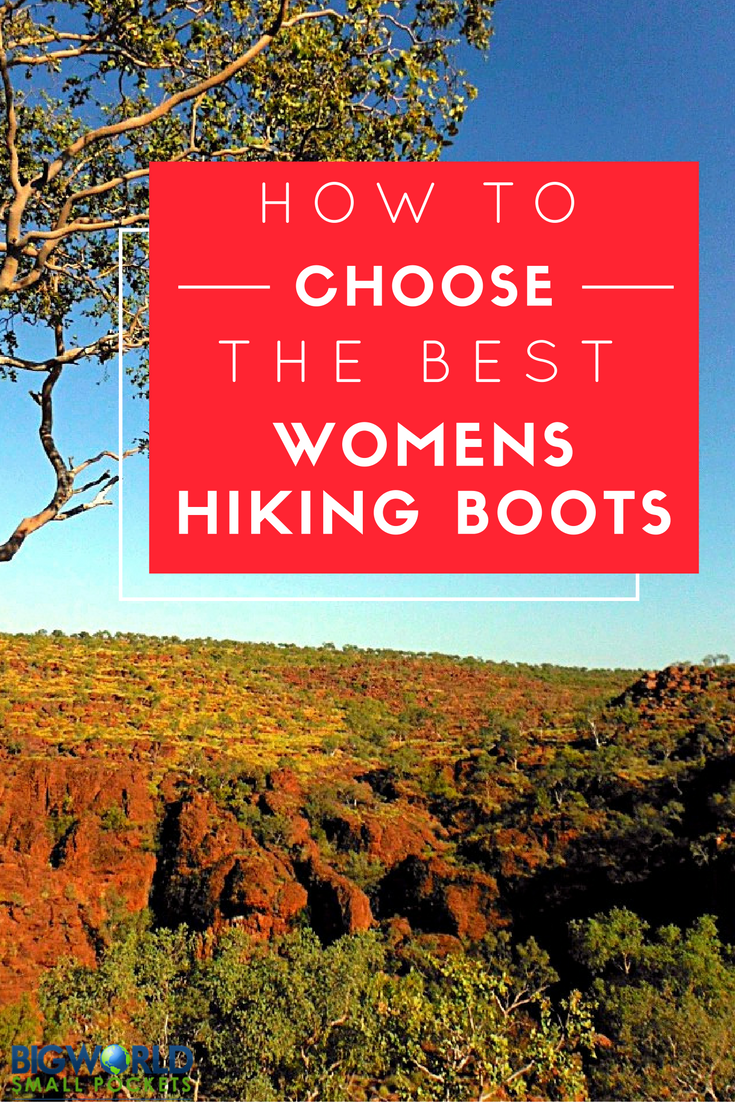Let’s be honest ladies, hiking boots are never going to be fashion item number 1!
They are, however, always going to be incredibly useful, especially when travelling the globe.
From Nepal to New Zealand, Namibia to Norway, womens hiking boots are a good, practical choice of footwear in all sorts of situations.
So, if you’re in a place where nobody really knows you and you want to hike, explore, camp or trek, then getting a decent pair is probably going to have more pros than cons.
This guide on how to choose the best womens hiking boots is a list to help get you started if you’re new to the whole affair.
With key criteria regarding what to look out for and key questions you want to ask in order to make the right choice, I hope this will be as useful a tool as your boots almost certainly will be.
Related Posts
- The Ultimate Backpacking South America Packing List
- 5 Best Hikes in New Zealand for Solo Females
- 7 Great Tips for Choosing the Best Hiking Sunglasses
This page contains affiliate links meaning Big World Small Pockets may receive a small commission on any purchases at no extra cost to you.
Hiking Boot, Shoe or Runner?
The first question in my guide on how to choose the best womens hiking boots ironically asks you to consider whether a hiking boot is actually what you need at all!
That’s because as well as boots, you can also buy hiking shoes or trail runners that might be more fit for purpose.
Womens Hiking Boots
Womens hiking boots are the tallest of the 3 options here, sitting further up your ankle and therefore giving this important joint more support.
Hiking boots are also heavier duty than other types of hiking footwear, with thicker soles that protect your feet on rough terrain.
Hiking boots are also more likely to be waterproof and to provide the best grip.
Due to their tougher nature, hiking boots generally last longer too and offer the best protection from scratches, scree or snakes!
Womens Hiking Shoes
Another option is womens hiking shoes, which are a lower cut type of trekking footwear.
Hiking shoes have more flexible soles than boots and therefore take less time to break in.
They are also lighter too, which might appeal to some. The hiking shoe’s decreased weight and height however do mean they offer less ankle support. As such, you might want to stick to a hiking boot if the ankle is a problem area for you.
Hiking shoes also offer you less protection from bushes or scrub when walking, so are probably your best option only if walking on well-maintained trails.
Hiking shoes do however still have good traction and are durable.
Womens Trail Runner
The other option is to forget the “hiking” thing altogether and opt for a trail runner.
These trainers will be lighter still than a hiking shoe and look more like a piece of fashion footwear if you want to wear them out when walking around cities too.
Their diversity appeals to many female travellers and for good reason.
Trail runners do still provide you with more traction than other footwear options and while not waterproof, they generally drain and dry quickly.
While they aren’t recommended if you’re carrying heavy loads, because there have less support, they are designed to keep your feet well ventilated. For this reason, trail runners might suit you better if you’re travelling in hotter climates.
I, for example, only took my New Balance Trail Runners with me to Central America and found them totally fit for purpose there.
As well as good for climbing up active volcanoes(!) I found them great when running, cycling or undertaking moderate day walks.
If you’re looking at a trail runner to take travelling, then I really recommend New Balance’s range as I find they fit incredibly well, are super lightweight and don’t look too bad either!
Just enter your details below and I'll email it you - simple!
Information will be sent to the email provided above
Use & Destination
So probably the best way to decide between womens hiking boots, shoes or trail runners is to think about what you might be using the footwear for when travelling. This will also have a large amount to do with where in the world you’re planning on going.
As I said before, if you’re looking at visiting tropical climates – perhaps Southeast Asia or Central America – then you definitely want something that will allow your feet to breathe. In this way, I’d recommend a trail runner.
If you’re just thinking about lying on the beach most days and occasionally doing the odd day trip or walk, then again a trail runner will probably suit you best, as they can easily just be tied onto the outside of your travel backpack when not in use.
If you’re planning on walking around cities a lot too, or using your footwear for more casual purposes as well as walking, then again I’d say a trail runner would work well.
If however, you’re going to colder climates and looking to do some more serious hiking – perhaps a couple of multi-day treks or mountain climbs in New Zealand, Europe or South America, then I really would recommend you looking at womens hiking boots.
Hiking shoes are ok, but for a few extra pounds, a boot will really give you a whole new level of support that I’m sure you’ll be grateful for. Let’s just say that I’ve never regretted taking my hiking boots anywhere!
Full Length vs. ¾
Ok, so let’s say you’ve opted for womens hiking boots, then you need to make another decision I’m afraid – I know, I hate them too!
This time, it’s about the height of the cuff of your boot, namely if you want a taller (above the ankle) pair or just a ¾ height (on the ankle) model? Normally these two options also correlate with whether you want a mid-weight or heavy boot.
As you might have guessed, above the ankle, heavier boots offer greater protection and support with thicker soles and better waterproofing.
They are ideal for really rough terrain that necessitates greater grip and greater resistance from the elements. They will, however, take longer to break in and might be a bit over the top if you’re not planning on serious mountain climbing or jungle trekking.
If you’re not going super hardcore therefore, then I suggest ¾ height, mid-weight womens hiking boots might suit you better.
I love my Hi-Tec Oregon II Hiking Boot because they have both a waterproof and breathable membrane. They also fit me really comfortably and proved a great level of support.
Mine are well used – I’ve had them for years – and they’re still going strong, which is always a good sign!
I’ve found them particularly useful when tackling things like the cliff paths of my home Island of Jersey and the Andean hikes in Ecuador in South America.
Sizing, Comfort & Support
So you’ve decided you want mid-weight womens hiking boots! Ok, well the next thing to make sure is that you get a boot that fits well. This is going to be crucial on the trail.
When trying on womens hiking boots, you want to make sure there’s still room for your toes to wiggle at the end. Don’t forget that when hiking, your feet will get hot and expand ladies, so a good amount of wiggle room now won’t necessarily mean lots of wiggle room when you’re on the trail.
Saying that, you don’t want to have your boot too big either. A good way to test for this is to walk in your boot and make sure there isn’t any heel slippage. If there is any, you can almost guarantee future blisters!
Always allow your boot time to break in before setting off on your adventures. Do some shorter walks to get your feet and boot used to each other and to soften up the boot’s materials slightly.
All womens hiking boots should offer good support – this is their key function. As such, you should feel like there is a good amount of arch support in your chosen hiking boot and that you are happy with the way the cuff of your boot hugs your ankle.
Comfort is key, so make sure your new boots got it!
Of course, it’s impossible to gauge all of this info without trying the boots on. Going into a store is a great way to get a feel of a boot.
However, if you’re clever and want to save some cash, I then recommend coming back home and searching online to see if you can find the same boot cheaper than the store price!
Equally, try to order online from a supplier that offers a 100% satisfaction guarantee and either refunds or replacements on returned items within 1 year of purchase.
One of the top selling womens hiking boot is the Keen Targhee II, which is a great mid boot that’s incredibly well priced and gets rave reviews.
With a patented toe guard design, as well as a waterproof and breathable membrane, it’s no wonder these Keen womens hiking boots are one of the most popular models around.
Waterproof & Breathability
So, as you can tell from the couple of womens hiking boots I’ve recommended, being waterproof is a key factor I look for in a boot.
This because it’s highly likely your hiking boots will come into contact with water at some point during their usage.
Whether this is during a stream crossing, beach walk or a good old rain shower, it always helps if a hiking boot is equipped to deal with this situation.
The main reason for this is that your feet will be more susceptible to blisters when wet.
Most womens hiking boot companies use a Gore-Tex lining to provide a waterproof membrane.
Many people believe waterproof linings are not compatible with breathability in a boot, but this just isn’t the case. There are plenty of waterproof womens hiking boots on the market that also boast excellent ventilation for your feet. Normally airflow is given through breathable mesh panels on the side of the boot.
One model that always gets rave reviews when it comes to the waterproof factor is the Women’s Lowa Renegade GTX, which is also very breathable and super lightweight.
If you select a hiking boot that isn’t waterproof, then consider trying to up its level of water resistance.
This can be done through a spray treatment coating with a product such as Kiwi Camp Dry Boot Protector. This will help to improve the water resistance of the boot and therefore its lifespan.
Lightweight
Hiking boots used to be very heavy, clunky things, but more and more nowadays, super lightweight models are coming onto the market.
This is great news for us travellers because as you all know, keeping weight down is a key mission for those on the road.
I highly recommend buying lightweight womens hiking boots if you can. This will also make walking a lighter and easier exercise and you’ll be happier to carry them when their not on your feet.
At under 1kg (2lbs) the Salomon Women’s Comet 3D Lady GTX are a really popular lightweight model, that you’ll be glad to know are also highly waterproof.
With great stability and durability, they have the best features of womens hiking boots coupled with the flexibility of a trail runner. Definitely something to consider!
Other Recommended Womens Hiking Boots…
Columbia Women’s Newton Ridge Plus Hiking Boot
Timberland Women’s Flume Mid Waterproof Boot Brown
SAVE THIS TO PINTEREST!
So that’s my guide on how to choose the best womens hiking boots.
Do you have a great pair of womens hiking boots you love and want to tell others to buy?
Let me know!
And, if you’re looking for some inspiration, check out these amazing places to hike in Europe!
If anything will get you excited about buying a new pair of boots it’s these photos!






I bought the exact Keens at REI for my trip to Iceland and they were perfect. They were so helpful finding the right shoes and inserts for me.
Great to know our recommendations are other people’s too! Hope you, and your Keens, enjoyed Iceland!
Great info. I’m glad you shared it.We are planning on doing some hiking in New Mexico this spring.
That will be wonderful Sher – glad you found the post helpful 🙂